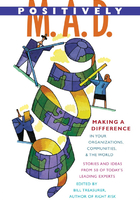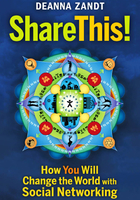EIGHT KEYS TO ENDING POVERTY
The following pages are chock-full of information about the state of business, government, and philanthropy today in light of our primary concern in this book: a desire to eradicate poverty. Lest you wonder why we've set out to tell you all this, please consider the following:
? If you're involved in the world of big business, you've surely encountered the reality of the “flat world” that Thomas Friedman has so eloquently described. The likelihood is that there's precious little room for growth in your traditional markets, and you're wondering where your new customers and new revenue will come from — or you know they have to come from emerging markets, but you don't yet understand how to do business in those markets. Conventional wisdom says you can't make money from the nearly three billion new customers we describe in this book — but we'll show you how you can.
? If you're a social entrepreneur, you may be frustrated with the difficulty you're probably having securing the funds you need to finance your venture. Impact investing has been around for a long time now, but disillusionment and cynicism are setting in — among social entrepreneurs like you because money is so hard to come by, and among impact investors who are skeptical that social enterprise has wrought much change. The field needs to get unstuck — and we believe we have the answer for you: a way to help end poverty and make enough money to keep investors happy.
? If you're professionally engaged in antipoverty work, whether at the United Nations, through a national government, or in an NGO, chances are you're having trouble raising money — and not just this month or this year, but constantly. Truth to tell, you're probably also having difficulty proving that the great results you've obtained are really adding up to much on a global scale. Although you're aware of the growing evidence that market-based approaches often work, you may be reluctant to try one because you know that traditionally, capitalist approaches have exploited poor people and done irreparable harm to the environment. But what we advocate is different: a way to achieve results on a global scale and solve your fundraising challenge without victimizing poor people or despoiling the environment.
? If you're a teacher, whether in college or at a university or graduate school, and whether your subject is business, social enterprise, international affairs, economic development, area studies, design, or poverty, you may find that this book is ideal to use as a text in your course. Your students will learn about a topic of great current interest — and find out how they can make a big difference in addressing one of the world's leading challenges. This book is filled with practical examples, step-by-step explanations, and references to sources and related literature.
? If you're engaged in the emerging field of “design for the other 90 percent,” the information you'll discover here will let you view your work in the broader context of day-to-day business concerns and the down-to-earth problems of working in an emerging nation and an unfamiliar culture. You'll find this book is bursting with practical, detailed recommendations about how to put your ideas into practice under real-world conditions.
Why Business Should Be Interested in Fighting Poverty
Because you're reading this book, you may feel, as we do, that poverty is humankind's greatest shame. But if you consider the matter for a moment, we're sure you would also agree that the scope and persistence of poverty doesn't just raise questions about the moral character of the human race. There are practical considerations, too.
Consider, for example, the horrendous waste of human talent. How many scientists, physicians, teachers, business innovators, gifted artists, and brilliant community leaders might emerge from the bottom billions if they were freed from the shackles of poverty? How much might all our lives be enriched if the 2.7 billion people who face the constraints of severe poverty today were given opportunities to fulfill their potential?
Consider, too, the prospect that the end of wide-scale poverty might lower the level of conflict in the world. Ethnic hatred, intercommunal violence, and religious extremism flourish in communities where few people are well educated. Moreover, the lack of economic opportunities and the institutionalized oppression prevalent in many political systems go hand in hand with violence, terrorism, revolution, and war.
Widespread poverty is also a root cause of a host of environmental problems that take their greatest toll on the poor themselves. Throughout the Global South, growing numbers of poor rural people overfarm already poor soils, cut down trees for fuel, use local lakes and streams as toilets and waste dumps, burn carbon-intensive fuels for cooking and heating, and compete for fast-shrinking supplies of water. Lack of education, high infant mortality, and the need for more hands to increase family income lead to overpopulation, which adds a multiplier effect to the existing pressure that humanity exerts on our dwindling resource base. Overpopulation is the biggest environmental factor of all, and it's getting bigger: practically all the projected increase in the world's population between now and 2050 will take place among people who live on $2 a day or less in the world's poorest countries.
All this adds up to a powerful moral and practical case for ending poverty. But there is also a compelling business case, as is obvious to any thoughtful strategic planner at a multinational firm with a global footprint. Five factors come to the fore in any serious analysis:
Huge market opportunity. A virtually untapped market numbering 2.7 billion potential customers is simply too big to overlook. The emerging economies of the Global South, not even counting China and Russia, collectively generate $12 trillion, or nearly one-fifth (18 percent) of the world's total economic output.[1] Remarkably, these trillions of dollars of purchasing power do not reside solely among the elites and the limited middle class of these developing nations: “In developing countries, more than 50 percent of the purchasing power resides in the [bottom of the pyramid] segment.”[2] These figures reflect current reality, but as today's poor move into the middle class, their purchasing power will multiply.
Crowded home markets. Dig a little below the surface of many of Europe's and America's biggest multinational companies, and you're likely to find that a large and growing percentage of their profits comes not from their traditional homelands but from the emerging markets of the Global South. Increasingly, the world's leading businesses are coming to realize that establishing themselves firmly in these new markets is a matter of corporate life and death. Notwithstanding the environmental problems caused by relentless industrial growth, the inescapable fact is that the transnational companies that already dominate the world's economy feel they must find ways to extend their reach among the bottom billions. The world's 2.7 billion poor people are, for global business, “the New Frontier.”[3]
Disruptive forces. Even a cursory reading of business history quickly leads to the realization that business is volatile and subject to frequent, sometimes disruptive change. When Charles Dow assembled the original Dow Jones Industrial Average in 1896, he selected 12 stocks to represent the strength of the US industrial sector.[4] Of those 12 companies, 2 have gone bankrupt, 2 were broken up by antitrust action, 4 were acquired by other corporations, and 3 operate today under new names but are no longer large enough to be counted among the Dow Jones 30. Only GE remains on the list. Equally important, the 30 companies that make up today's list prominently feature corporations in industries entirely unknown to investors in the Gilded Age: jet airplanes, networking systems, microprocessors, wireless communications, and others. Disruptions in the world of business never stop coming. Remember Tower Records? Blockbuster? Kodak? All three were billion-dollar companies until just a few years ago, and all three are now history. To cite another recent and familiar example: One day General Motors is coasting along, the largest industrial corporation in the history of the world — and the next day Toyota is eating its lunch, selling millions of smaller, lighter, cheaper cars that respond to the American public's growing appetite for fuel efficiency. Now Toyota itself faces a challenge from Korean and Chinese automakers, which are beginning to invade its markets. In business, life is change. No well-managed corporation with global aspirations can afford to overlook new market opportunities.
Growing interest within big business. Some large corporations have already successfully demonstrated that an established company can move significantly down market and make a profit, while stealing a march on competitors. For example, Walmart now operates in 27 countries, including Mexico, Argentina, Brazil, and much of the rest of Latin America; most of southern and eastern Africa; and both South and East Asia. Hyundai, which sells vehicles in 193 countries, is India's second-largest auto exporter, and three of its models are among the top 15 best-selling cars there. Unilever generates more than half of its sales and a disproportionate percentage of its profits in emerging markets, where Procter & Gamble lags to its disadvantage. Cummins started making diesel engines in China 25 years ago, after Richard Nixon's visit, and now China, India, and Brazil lead the company's profitability and growth. Mahindra overtook US tractor makers Caterpillar and John Deere by introducing small, affordable tractors not just in India, where it's based, but in the US market and elsewhere, seizing first place worldwide in tractor sales. All these companies have taken the first step, providing products and services for the middle class in emerging nations. Eventually, they may be forced to take the next step and serve $2-a-day customers as well.
Access to scarce resources. Poor people happen to live right next to a surprisingly high proportion of the world's natural resources, and their hands-on participation is required to gain access to these resources. Let's look at gold in the Amazon basin as an example, where tens of thousands of poor miners are participating in a renewed gold rush and polluting the planet in the process.[5] Here's an opportunity to create a new market that helps millions out of poverty — while sharply lessening the environmental damage by introducing more sustainable methods. Let's also look at the fact that most of the fresh water on Earth is located where few people live — except poor people. Is this not an opportunity to create a transformative new market, “harvesting” water in ways that improve the health of millions, distribute the bounty more fairly, reduce the waste of water in agriculture, and profit local residents? Similarly, let's ask where most of the sunlight that reaches land falls on our planet. (Hint: it's not in the cities.) Consider also the potential use of the enormous quantities of waste biomass created when crops are harvested on scattered small farms where poor people live all over the globe: biomass can be converted into a form of low-carbon coal to lower by 20 percent the emission of greenhouse gases from power plants fueled with coal. These natural resources add up to a treasure house of potential business profit (and benefits to those who live nearby) that, in the long run, industry simply will not be able to ignore.
Most emerging countries are characterized by a tiny elite who share the cosmopolitan values of Europe and North America and a large mass of poor people whose lives are circumscribed by geography, custom, ethnicity, gender, and religion as well as socioeconomic status. The elite typically constitute a market that's too small to justify the expense of setting up shop in an underdeveloped and often unstable country. Some businesses have successfully launched products that serve the middle class in these countries, but this market already has strong competition. The true business opportunity lies among the bottom billions. Selling to these billions of people requires a revolutionary shift in business thinking — beginning before products and services are even conceived. This is a difficult hurdle for any business to leap, but it can be done, as we'll demonstrate in this book.
Nearly a decade ago, a distinguished marketing professor at the University of Michigan piqued the interest of the business world about the poor as potential customers with The Fortune at the Bottom of the Pyramid. That professor, C.K. Prahalad, devised a brilliant title — a catchphrase that has ricocheted around cyberspace and entered the English language. Unfortunately, the case studies included to illustrate the book's concept, with their focus on customers earning $5 to $10 a day, failed to do so with one exception (Aravind Eye Care System, a nonprofit organization in India).[6]
Still, perhaps inspired by the magical promise of “the bottom of the pyramid,” many of the world's largest and most successful companies tried to enter emerging markets — with generally mixed success at best. To their chagrin, they discovered that consumers in markets where poverty is prevalent don't behave the same way that consumers do in First World markets. The mistake so many businesses committed was to make “adjustments” to their existing products and services, eliminating features, using cheaper materials, lowering quality, rebranding them more cheaply — and thus cutting costs — only to discover that the resulting wares were unsalable because they failed to meet the needs, expectations, and aspirations of poor customers.[7] The products and services of most of those companies were focused on customers earning $5 to $15 a day — solid members of the middle class in local terms and not the poor we're writing about.
There is a better way. By following the approach outlined in The Business Solution to Poverty, a company can earn substantial profits by designing and selling products and services that satisfy the immediate needs of people who exist on the margins of survival — their needs as they themselves describe them to you. We will spell out practical ways to do this — 100 million customers at a time. Later, as their fortunes improve and they move upward into the middle class, still brand-loyal, they will become the base of the company's more affluent customers, buying more evolved models of its original products and services as well as new products to fit their new lifestyles. Trickle-up economics works much better than trickle-down!
Do not mistake the businesses we're proposing as philanthropic ventures. In fact, these businesses are designed to realize generous profits while fulfilling their social mission. As Erik Simanis wrote in the Harvard Business Review, “Because the high costs of doing business among the very poor demand a high contribution per transaction, companies must embrace the reality that high margins and price points aren't just a top-of-the-pyramid phenomenon; they're also a necessity for ensuring sustainable businesses at the bottom of the pyramid.”[8] Simanis might have added that high margins are necessary when doing business among the very poor because of the high costs of delivering goods and services outside of cities, as well as the high risks involved, since so very few businesses have ventured into this market and there's so much to learn about it.
How We Propose to End Poverty
For the purpose of this book, we define poverty (and the bottom of the pyramid) as encompassing those families who live on the equivalent of $2 a day or less per person. Thus, some 2.7 billion people, or about three of every eight on Earth, fall under our definition of poverty, including about one billion, or one in seven, who live on $1 a day or less.
Despite the extraordinary rush to the world's cities, most of these 2.7 billion poor people still live in rural areas. As the United Nations reported not long ago, “The number of rural dwellers is high and still growing. In 2005, there were 3.3 billion rural dwellers, equal to the world's population in 1965” — including some 800 million in India alone, and an equal number in China.[9] Although data is hard to come by, and what's available is sometimes questionable, it's safe to say that a majority of the world's poor today live in rural areas. They're the focus of our concern in this book.
Although we refer to the Global South in general throughout this book, poverty is by no means distributed equally throughout that vast span of territory. In fact, the lion's share of the poor is concentrated in just four areas. The Indian subcontinent (including India, Pakistan, Bangladesh, Nepal, Bhutan, and Sri Lanka) is home to what we estimate are some 900 million poor people. Southeast Asia (Myanmar, Vietnam, Laos, Cambodia, Thailand, Malaysia, Indonesia, Papua New Guinea, and the Philippines) holds 700 million more, with roughly 500 million in sub-Saharan Africa (the dozens of nations that lie south of the Arabic-speaking countries on the Mediterranean coast). China today may be home to some 300 million people living on $2 a day or less. The number of poor in these four regions totals approximately 2.4 billion. The remaining 300 million are scattered globally.
The remedy we propose is to tap the mainstream capital markets to fund large-scale, global enterprises that address the basic needs of these 2.7 billion people: needs for clean water, renewable energy, affordable housing, accessible health care and education, and, above all, jobs. The Business Solution to Poverty will spell out exactly how big global businesses launched either by independent entrepreneurs or by existing multinational corporations can earn profits large enough to attract substantial amounts of capital by satisfying these needs — and lifting millions into the middle class in the process. Each of these businesses, we believe, must set a 10-year goal of building a customer base of at least 100 million, achieving revenues of $10 billion or more per year, and realizing sufficient profitability to attract both indigenous and international commercial investors while minimizing its environmental impact to the greatest extent possible.
Eight Keys to Ending Poverty
The approach we advocate to end poverty doesn't follow a simple formula. You can't write it all down on a prescription pad. However, it is systematic. We call it zero-based design.
To understand what we mean by this term, consider the analogy we've based it on: zero-based budgeting. Typically, next year's budget is simply this year's with a few adjustments. Sometimes the process is straightforward: just increase or decrease last year's numbers by 2 percent or 10 percent, and — voilà! — you've got next year's budget. By contrast, in zero-based budgeting, you start from scratch. Zero. With every line item blank, you dig as deeply as you need to dig to learn what's really necessary and feasible.
Practically all designers set out on any assignment with a set of assumptions in mind — either a template they've successfully used in the past to solve a similar problem, or an existing product or service they plan to modify, or — at the very least — a conviction that they've run across similar challenges in the past and can rely on their own experience in addressing them. In zero-based design, none of these assumptions are acceptable.
You begin the zero-based design process from a position of assumed ignorance. Because you possess experience in, say, building homes, you might set out to establish a new business that provides healthy and comfortable housing for $2-a-day people who now live in the most rudimentary shelters. However, instead of thinking of ways to adapt an existing home design to local conditions, you assume that nothing you have previously done will be suitable. You set out instead to determine what poor people themselves believe will best meet their needs. The process entails asking a lot of questions — questions at every stage of inquiry.
There are eight keys to applying zero-based design to the conceptualization and implementation of a business that will market essential products or services to people living on $2 a day or less and be profitable enough to attract the capital necessary to reach global scale. By employing these principles in an integrated, bottom-up design process, you can fashion an enterprise that will truly help millions of severely poor people move out of poverty:
Listening. Don't look at poor people as alms-seekers or bystanders to their own lives. They're your customers. Always set out by purposefully listening to understand thoroughly the specific context of their lives — their needs, their wants, their fears, their aspirations.
Transforming the market. Think like Steve Jobs or Akio Morita (“I don't serve markets. I create them!”).[10] Your goal is to put a dent in the universe. A transformative new market will mimic the chain reaction in an atomic explosion, releasing energy to create yet bigger explosions. With success, your business will change economic behavior, create huge numbers of new jobs, and transform the character of villages around the globe.
Scale. Design for scale from the very beginning as a central focus of the enterprise, with a view toward reaching not just thousands or even millions of poor people but hundreds of millions. Scale isn't mysterious; it's fundamentally a mechanical process. You begin with a pilot project in, say, 50 villages. With success, you roll out to 50 villages per month, then to 250 per month, and later to 500 or 1,000, building on what you learn as you go.[11] You always keep in mind that you've set out to design a global enterprise — a profitable and sustainable working system, not simply a product or service.
Ruthless affordability. Design and implement ruthlessly affordable technologies and supremely efficient business processes, offering prices not just 30 to 50 percent less than First World prices but often an order of magnitude less, or 90 percent.
Private capital. Design for a generous profit margin so that you can energize private-sector market forces, which will play a central role in expanding any venture — drawing from a pool of trillions of dollars in private capital rather than the millions typically available for philanthropic or government-sponsored programs.
Last-mile distribution. Design for radical decentralization that incorporates last-mile (even “last 500 feet”) distribution, employing local people at local wages in a marketing, sales, and distribution network that can reach even the most isolated rural people.
Aspirational branding. This is even more critical for $2-a-day markets than for those serving the top 10 percent. Without aspirational branding that generates in buyers' minds an appreciation for its most widely appreciated benefits and attributes, Coca-Cola is just flavored, fizzy sugar water, and a Mercedes is only a high-priced car. Branding convinces us that paying a premium for these products will make our lives more rewarding.
Jugaad innovation. The Hindi term jugaad connotes improvisation, working with what you have, and paying unflinching attention to continuous testing and development. A cynic might call it simply ingenuity.
These eight ideas form the basis of the zero-based design approach we'll present in the pages that follow.
A Few Words about Jargon
Every field of endeavor is cluttered with specialized terms and definitions that frequently make little sense to an outsider, and the worlds of business and economic development are most certainly not strangers to this annoying practice. But fear not: we'll do our best to avoid or explain any words or phrases not in general use. For starters:
Global South. This is a term of art that transcends geography. It refers to the generally less-developed, low-income countries typically classified as “developing nations,” “underdeveloped countries,” and “emerging nations” — despite the fact that most of India, for example, lies north of the Equator, and Australia and New Zealand, which are by no means underdeveloped, lie far to the south of the line. We use all these terms interchangeably, even though some sticklers for precision in the economic development field distinguish between “developing” and “emerging” nations. (The latter are presumably those that are further along in the development cycle and are emerging as forces in the world economy. But who's to say that one country deserves to be called emerging and another doesn't?)
The West. Even though this term was robbed of meaning when Japan prevailed in the Russo-Japanese War more than a century ago, it's still commonly used by journalists, scholars, and most of the rest of us. We object. The countries that are commonly grouped under this heading are, for the most part, the planet's wealthiest and most developed nations. We intend to refer to them in that fashion or as the Global North or the First World. Some readers may object, but we can take the abuse.
Social enterprise. We're aware that some practitioners in this field still quarrel over the definition of this term.[12] However, from our perspective, a “social enterprise” is an organization whose primary purpose (“mission”) is to address a social, economic, or environmental problem experienced by a large number of people. Any such enterprise may be organized as either a for-profit or nonprofit entity. So-called hybrid businesses — L3Cs (low-profit limited liability companies) and B Corporations, or Benefit Corporations in the United States and Community Interest Companies in the United Kingdom — are, by this definition, social enterprises. To be clear, the companies we advocate forming in The Business Solution to Poverty are social enterprises in the sense that they're designed to meet social, economic, or environmental needs. We advocate embedding the social goals of a business clearly into its mission, and then focusing single-mindedly on making the business profitable, because otherwise it won't be able to attract the large-scale infusion of capital required to achieve global scale. For example, if an enterprise adopts the mission of selling crop insurance to large numbers of poor farmers at an attractive price, embeds that mission into its DNA, and never wavers from it, transformative social impact is inevitable. The real challenge is earning attractive profits while doing it.
In any enterprise, whatever its goals, there's only so much money to go around. Businesses constantly confront trade-offs between retaining revenue for profits and using it for any one of innumerable other purposes — raising the quality of its products and services, hiring more employees, or paying existing staff higher wages, for example. We find that impact investors consistently confuse this question. Social impact and profitability are not mutually exclusive. If a business is truly dedicated to a social mission such as providing electricity at an acceptable price to millions of people who live on $2 a day or less and would otherwise continue to live in the dark, it's not just appropriate that the company earn good profits — it's imperative. Otherwise, the business will be unable to grow and deliver electricity to millions more.
Stakeholder-centered management. Among the trade-offs that business will nonetheless face are those between profitability, on the one hand, and product quality, environmental impact, and wage levels, on the other. We don't believe that any business can thrive over the long term unless, in addition to pursuing a meaningful social mission, it sells high-quality goods and services, pays livable wages to its employees, and avoids any harmful environmental impact. These are central features of what we term stakeholdercentered management, an approach that requires us to take into account the needs of all stakeholders when addressing those trade-offs — the employees, the local community or communities, the environment, and the suppliers, as well as the customers and the owners. Is it also important to spend large sums of money measuring and reporting on the company's performance in those terms? We don't think so — at least not in the early years. Making money is hard enough. Perhaps a multinational company that's already highly profitable can afford to invest in the newly emerging practice of integrated reporting, which covers all aspects of a business's performance. It may even be important that such a company do so. But for a fledgling social enterprise delivering essential goods and services to the world's poor, such expenditures would drain profits essential to its growth.
In addition to these perhaps idiosyncratic uses of words, there is one other atypical convention you'll find in this book. For simplicity's sake, we'll consistently use the “$” symbol to denote US dollars. This is ethnocentric on our part, but we never said we were perfect. We'll also generally use units of measurement in the Imperial system (miles, pounds, gallons, and so forth), but we'll place the metric equivalents within parentheses as often as seems necessary.
How This Book Is Organized
We hope the text that follows will seem straightforward and easy to read. We've included no sidebars or other distractions to draw your attention away from the arc of the story we're telling.
Part one, “Only Business Can End Poverty,” introduces you to your new customers and to poverty as they experience it, reviews why poverty persists, explains why we're convinced that business is the solution, and details the essential roles that government and philanthropy can play.
In part two, “Zero-Based Design and the Bottom Billions,” we demonstrate, in practical terms and with abundant examples, what we mean by zero-based design and how you can put it into practice, step by step.
Part three, “Opportunities Abound,” concludes this book with a description of the four new companies Paul is establishing and a list of the additional opportunities in water, power, health care, education, insurance, housing, and other fields that are just waiting to be seized by venturesome and dedicated entrepreneurs or existing multinational corporations.
The Business Solution to Poverty ends with a list of the takeaway ideas highlighted in the book and with an appendix in which we relate the qualms and complaints that friends registered as we wrote this book — and our responses to their reservations.
Naturally, in the course of researching this book, we've come across a rich trove of resources that illuminate the issues broached here. In past years, we would have appended a resource list at the end. However, in today's fast-changing world, we opted instead to post that material online, where it can be readily updated. The address for the website we built for this purpose is at www.businesssolutiontopoverty.com. We invite you to visit the site and register any comments or ideas you may have about this book or the issues or examples we've written about.
Meanwhile, enjoy what follows! We wrote it for you.
注释:
[1]International Monetary Fund, Report for Selected Countries and Subjects, 2011.
[2]Rodrigo Guesalaga and Pablo Marshall, “Purchasing Power at the Bottom of the Pyramid: Differences across Geographic Regions and Income Tiers,” Journal of Consumer Marketing 25, no. 7 (2008): 413–18.
[3]Consider, for example, the ongoing rivalry between Procter & Gamble and Unilever. Although the two companies are dissimilar — P&G is above all a manufacturer and Unilever a trader by heritage — they compete head-to-head all across the globe. Both companies are struggling to increase their reach into developing markets. In 2012, P&G anticipated that 37 percent of its total revenues would come from developing countries (up from 34 percent in 2010 and 23 percent in 2005). However, by 2012 Unilever was already gaining 56 percent of its revenue from developing markets (up from 53 percent in 2010) — with a target of 70 percent by 2020. Which of these two companies is better positioned to be dominant in the world ahead — and, in view of intensifying competition and tightening margins in developed markets, which is likely to be more profitable? “Fighting for the next billion shoppers: The eternal battle between Procter & Gamble and Unilever is intensifying in the developing world,” Economist, June 30, 2012.
[4]“The First 120 Years of the Dow-Jones,” Also, see Wikipedia, “Dow Jones Industrial Average,” Those first 12 stocks were American Cotton Oil Company; American Sugar Company; American Tobacco Company; Chicago Gas Company; Distilling & Cattle Feeding Company; General Electric Company; Laclede Gas Company; National Lead Company; North American Company; Tennessee Coal, Iron and Railroad Company; US Leather Company; and United States Rubber Company.
[5]“The Gold Mines of the Amazon,” Poverty News Blog, April 29, 2009,
[6]C.K. Prahalad, The Fortune at the Bottom of the Pyramid: Eradicating Poverty Through Profits, revised and updated 5th anniversary edition (Philadelphia: Wharton School Publishing, 2009). Prahalad defined the “bottom of the pyramid” as consisting of four billion people, a rather larger number than most observers count as poor by global standards. The number roughly corresponds to the cohort of people who live on $5 a day or less, a much more affluent group than we're addressing.
[7]The explosion of mobile phone access at the bottom of the pyramid provides an instructive exception — an exception that proves the rule in the sense that fast-changing technology and intensive competition, both of which are atypical among the bottom billions, have slashed prices to levels that are well within the reach of many poor people.
[8]Erik Simanis, “Reality Check at the Bottom of the Pyramid,” Harvard Business Review, June 2012,
[9]United Nations DESA, Population Division, “World Urbanization Prospects: The 2005 Revision, Fact Sheet 6,” 18,
[10]Akio Morita, Edwin M. Reingold, and Mitsuko Shimomura, Made in Japan: Akio Morita and Sony (New York: Signet Books, 1988).
[11]To put these numbers in perspective, keep in mind that India alone has an estimated total of 680,000 villages.
[12]For example, some scholars insist there's a difference between “social enterprise” and “social entrepreneurship,” which we think is silly. It's been a long time since the term “social enterprise” was limited to profit-making subsidiaries or divisions of nonprofit organizations that weren't necessarily entrepreneurial.















